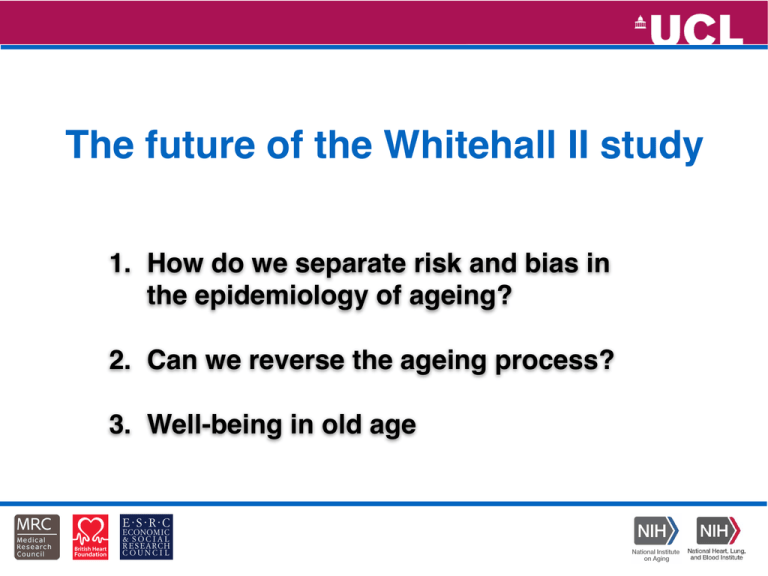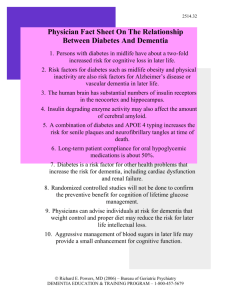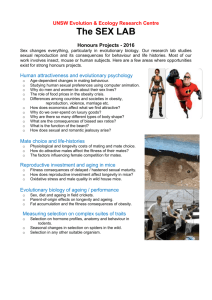The future of the Whitehall II study
advertisement

The future of the Whitehall II study 1. How do we separate risk and bias in the epidemiology of ageing? 2. Can we reverse the ageing process? 3. Well-being in old age Maximising the use of Whitehall II data to advance scientific knowledge High-power research consortia High-throughput discovery substudies 1985-88 N = 10,308 1991-94 N =1997-99 8,815 N = 7,870 IPD-Work Psychosocial Atheroscler osis cIMT 2002-04 N = 2007-09 6,967 N =2012-13 6,761 UCLEB genetics N = 6,318 2015-16 In progress 2019-20 METABOCHIP Emerging Risk Factor Collaboration LIFEPATH (immunity) Scan Brain MRI Heart Scan Planned 2023 Planned 2027 Planned GIANT EULIFEPATH Sharing of anonymised data to high-quality bona fide research - Data sharing policy - Europe USA Japan Australia 1. How do we separate risk and bias in the aetiology of ageing Randomised controlled trials represent the gold standard, but most trials offer only a relatively short period of surveillance The results based on ‘Big Data’ (e.g., electronic medical records) are precise, although not necessarily free of bias. Highly phenotyped cohort studies with long follow-ups, such Whitehall II, have a crucial role to obtain reliable evidence on disease • Antidepressants a risk factor for type 2 diabetes? • Healthy obesity a harmless condition? • Obesity and hypertension protecting against dementia? Nested case-­‐control study: Selection of cases and controls UK GPRD Andersohn et al. Am J Psychiatry 2009 The General Practice Research Database, UK Rate ratio for incident diabetes 2 1.75 1.5 1.25 1 Nonuse <12 m 12-24 m Exposure to antidepressants Andersohn et al. Am J Psychiatry 2009 >24 m Antidepressants taken by hundreds of thousands of people may increase the chances of developing diabetes, researchers warn Diabetes Prediabetes Diabetes Prediabetes Tabak et al. Lancet 2009 Antidepressant use and risk diabetes in cohort studies with serial phenotyping 10 Risk ratio for incident diabetes Diagnosed diabetes 2.34 Undiagnosed diabetes 2.13 1 0.91 0.88 Nonuse Antidepressant use 0.1 Whitehall II NHANES Whitehall II NHANES Kivimaki et al. Biol Psychiatry 2011 Mezuk et al. Health Psychol 2013 Cu 1 The Whitehall II study, UK D.E.S.I.R, France (N = 5978) (N = 4700) 9 year change Time (15 years) Kivimäki et al. Biol Psychiatry 2011 Da Silva et al. Int J Epidemiol 2015 The Natural Course of “Metabolically Healthy Obesity” The clinical value of “healthy obesity” rests on the assumption that it is a stable physiological state. Metabolic health refers to the absence of • • • • • hypertension low HDL-cholesterol high triglycerides insulin resistance high glucose The Natural Course of “Metabolically Healthy Obesity” 60 Becoming unhealthy obese, % Healthy normal weight Healthy obese 45 30 15 0 0 5 10 Follow-up period, years Bell et al. JACC 2015 15 Whitehall II shows “healthy obesity” is a transient phase of obesity-associated metabolic deterioration Age- and sex-standardised rates of dementia per 1000 person-years by body mass index in 1.9 million UK adults Electronic medical records Underweight Normal Overweight Obese Qizilbash et al. Lancet DE 2015 NEWS Being overweight 'can cut risk of dementia’ 10 April 2015 Last updated at 16:20 BST Being overweight cuts the risk of dementia, according to the largest and most precise investigation into the relationship. The researchers admit they were surprised by the findings, which run contrary to current health advice. The analysis of nearly two million British people, in the Lancet Diabetes & Endocrinology, showed underweight people had the highest risk. 17,008 individuals with AD 37,154 cognitively normal controls 2. Can we reverse the ageing process? The shared aetiology of common agerelated diseases • For several adult-onset diseases, age is the strongest risk factor • Blood - a circulating global regulator (plausible plus open to therapeutics)? Oeppen et al. Science 2002 • Animal models suggest there may be blood-related modulators of ageing (loss of homeostasis; defective repair after injury; dysfunctions affecting multiple distinct tissues semisynchronously) • Repeat clinical examinations will enable testing blood-based ageing in humans Heterochronic parabiosis reverses age-related cardiac hypertrophy Loffredo et al. Cell 2013 Parabiosis: a class of techniques in which two living organisms are joined together surgically and develop single, shared physiological systems, such as a shared circulatory system Growth differentiation factor 11 The heart weight-to-tibia length ratio was significantly lower in old mice exposed to a young circulation (O-HP) compared to old mice exposed to an old circulation (O-IP) for 4 weeks and to old unpaired mice (O). No significant difference was observed when comparing old isochronic to old unpaired mice or when comparing any of the young groups. Heterochronic parabiosis enhances neurogenesis and cognitive functions in the ageing mouse Quantification of neurogenesis in the olfactory bulbs of old (B) and young (C) parabionts. (n=4, *p<0.05). (D) Measurement of the exploratory time during the olfactory sensitivity assay (n=3). Data shown as mean±S.E.M Katsimpardi et al. Science 2014 Improved kinetics of healing of dorsal wounds in diabetic (db) mice exposed to a wild-type (wt) systemic milieu (a) Open wound area decreased over time in all animals; however, wound healing in db control pairs (db-control) was generally slower than in wt pairs (wt-control). On day 7, db animals joined to wt partners exhibited significantly increased wound closure when compared with db-controls (n=12 per group). Results are shown as meanSD, *=P<0.05 for db chimera compared with db control group. (b) Granulation tissue area increased 3.9-fold under chimeric parabiotic conditions in db animals (db-chimera) compared with db controls (db-controls, n=6 per group). * P<0.05 for comparison indicated. Pietramaggiori et al. JID 2009 Blood parameters from age 35 into old age 1985-88 N = 10,308 35-55 1991-94 N = 8,815 1997-99 N = 7,870 2002-04 N = 6,967 Blood samples - Standard blood parameters - Immune markers - 200 metabolites covering amino acid metabolism, gluconeogenesis, ketogenesis, kidney and liver metabolism, and detailed lipid and lipoprotein metabolism Follow-up of age-related morbidity and functional impairment 2007-09 N = 6,761 2012-13 N = 6,318 2015-16 In progress 2019-20 Planned 2023 Planned 2027 Planned 77-97 3. Well-being in old age Study of social and psychological resources from across the life course that contribute to well-being at older ages. Midlife and old-age determinants of functional abilities that are essential if older people are to continue to do things they value and enjoy, despite disease or reduced longevity. Identify age-friendly environments that provide older people with opportunities for personal growth and to make contributions to their communities while retaining autonomy



